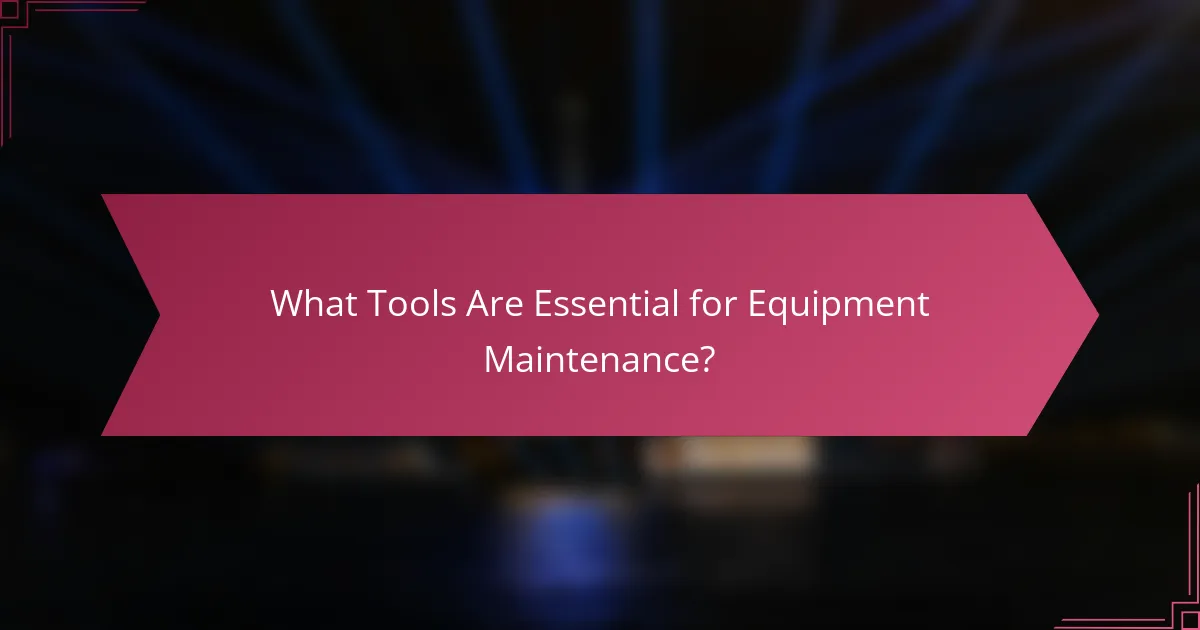Proper equipment maintenance is crucial for ensuring longevity and optimal performance. This involves regular checks, effective cleaning practices, and appropriate storage solutions. By following manufacturer guidelines and implementing a structured maintenance routine, you can significantly enhance the lifespan and functionality of your equipment.

How to Maintain Equipment Effectively?
Effective equipment maintenance involves regular checks, timely servicing, and adherence to manufacturer guidelines. By implementing a structured approach, you can extend the lifespan of your equipment and enhance its performance.
Regular inspections
Conducting regular inspections is crucial for identifying potential issues before they escalate. Schedule these checks at consistent intervals, such as weekly or monthly, depending on the equipment’s usage and complexity.
During inspections, look for signs of wear, loose components, or leaks. Keeping a checklist can help ensure that no critical areas are overlooked.
Scheduled servicing
Scheduled servicing should be part of your maintenance plan to ensure equipment operates efficiently. This may include changing fluids, replacing filters, or calibrating settings based on the manufacturer’s recommendations.
Establish a servicing calendar that aligns with your equipment’s usage patterns, ideally every few months or as specified in the user manual. This proactive approach minimizes unexpected breakdowns.
Using manufacturer guidelines
Always refer to the manufacturer’s guidelines for specific maintenance instructions tailored to your equipment. These guidelines provide essential information on proper care, including recommended cleaning methods and service intervals.
Following these instructions can prevent voiding warranties and ensure compliance with safety standards. Keep a copy of the manual accessible for quick reference.
Training staff on maintenance
Training staff on proper maintenance practices is vital for effective equipment care. Ensure that employees understand how to perform routine checks and recognize signs of malfunction.
Consider conducting regular training sessions or workshops to reinforce best practices. This investment in knowledge can lead to improved equipment reliability and reduced downtime.
Documenting maintenance activities
Documenting maintenance activities creates a reliable record of all inspections, services, and repairs performed. This documentation helps track equipment history and can be useful for audits or warranty claims.
Use a simple logbook or digital system to record dates, actions taken, and any issues encountered. Regularly reviewing this information can help identify patterns and inform future maintenance strategies.

What Are the Best Cleaning Practices for Equipment?
The best cleaning practices for equipment involve using suitable cleaning agents, adhering to recommended cleaning frequencies, employing safe cleaning techniques, and ensuring proper drying. These practices help maintain equipment functionality and prolong its lifespan.
Using appropriate cleaning agents
Selecting the right cleaning agents is crucial for effective equipment maintenance. Use cleaners that are specifically designed for the material of your equipment to avoid damage. For example, stainless steel may require a different cleaner than plastic or rubber components.
Always check the manufacturer’s guidelines for recommended cleaning products. Avoid harsh chemicals that can corrode or degrade surfaces, and consider eco-friendly options when possible to minimize environmental impact.
Cleaning frequency recommendations
Establishing a cleaning schedule is essential for maintaining equipment performance. For high-use equipment, cleaning may be necessary daily or weekly, while less frequently used items might only need monthly maintenance. Adjust the frequency based on the equipment’s operating environment and usage intensity.
Regular inspections can help determine if more frequent cleaning is needed. For instance, equipment exposed to dust or moisture may require more frequent attention to prevent buildup and potential malfunctions.
Safe cleaning techniques
Employ safe cleaning techniques to protect both the equipment and the user. Always disconnect equipment from power sources before cleaning to prevent accidents. Use soft cloths or brushes to avoid scratching surfaces, and apply cleaning agents sparingly to prevent oversaturation.
When using sprays, apply them to the cloth rather than directly onto the equipment to control the amount used and prevent liquid from seeping into sensitive areas. Follow up with a thorough wipe-down to remove any residue.
Importance of drying equipment
Properly drying equipment after cleaning is vital to prevent rust and corrosion. Water left on surfaces can lead to deterioration over time, especially for metal components. Use a clean, dry cloth to wipe down all surfaces after cleaning.
For larger equipment, ensure adequate air circulation to facilitate drying. If possible, allow equipment to air dry completely before storing it away. This practice helps maintain the integrity and functionality of the equipment for future use.

How to Store Equipment Properly?
Proper equipment storage is essential for maintaining functionality and extending lifespan. This involves creating an environment that protects the equipment from damage, ensuring it is organized and easily accessible.
Optimal storage conditions
Equipment should be stored in a clean, dry, and temperature-controlled environment to prevent rust, corrosion, and other forms of deterioration. Ideal temperatures typically range from 15°C to 25°C (59°F to 77°F), with humidity levels kept below 50% to avoid moisture-related issues.
Consider using dehumidifiers or climate control systems if your storage area is prone to high humidity or temperature fluctuations. Regularly check conditions to ensure they remain within the optimal range.
Use of protective covers
Using protective covers can significantly reduce wear and tear on equipment during storage. Covers should be breathable to prevent moisture buildup while providing a barrier against dust and debris.
Choose covers made from materials that are suitable for the specific type of equipment. For instance, UV-resistant covers are ideal for outdoor equipment to prevent sun damage.
Organizing storage space
Efficient organization of storage space enhances accessibility and protects equipment from accidental damage. Use shelving, racks, and bins to keep equipment off the ground and clearly labeled.
Consider grouping similar items together and maintaining a clear pathway for easy movement. This not only saves time when retrieving items but also minimizes the risk of accidents.
Inventory management systems
Implementing an inventory management system helps track equipment usage and storage locations. This can be as simple as a spreadsheet or as sophisticated as specialized software that monitors equipment condition and usage frequency.
Regularly update the inventory to reflect changes, ensuring that all equipment is accounted for and maintained appropriately. This practice can help identify items that need servicing or replacement, ultimately saving costs in the long run.

What Tools Are Essential for Equipment Maintenance?
Essential tools for equipment maintenance include basic hand tools, cleaning supplies, diagnostic tools, and proper storage solutions. These tools help ensure that equipment remains in good working condition, prolonging its lifespan and enhancing performance.
Basic hand tools
Basic hand tools are fundamental for any maintenance task. Common tools include wrenches, screwdrivers, pliers, and hammers, which are necessary for assembling, disassembling, and adjusting equipment. Investing in a quality set can save time and improve efficiency.
When selecting hand tools, consider ergonomics and durability. Look for tools made from high-quality materials that can withstand regular use. A well-organized toolbox can also streamline your workflow and minimize downtime.
Cleaning supplies
Cleaning supplies are crucial for maintaining equipment performance and appearance. Essential items include degreasers, brushes, cloths, and specialized cleaning solutions tailored to specific materials or components. Regular cleaning prevents buildup that can lead to malfunctions.
When choosing cleaning supplies, ensure they are compatible with the equipment’s materials. For instance, avoid harsh chemicals on sensitive surfaces. Establish a cleaning schedule based on usage frequency to keep equipment in optimal condition.
Diagnostic tools
Diagnostic tools help identify issues before they escalate into major problems. Common tools include multimeters, pressure gauges, and software for monitoring equipment performance. These tools can provide valuable insights into the health of your equipment.
Investing in diagnostic tools can lead to significant cost savings by preventing unexpected breakdowns. Familiarize yourself with how to use these tools effectively, and consider training for staff to enhance troubleshooting skills.
Storage solutions
Proper storage solutions are essential for protecting tools and equipment from damage. Use toolboxes, pegboards, or storage cabinets to keep items organized and easily accessible. This not only saves time but also reduces the risk of losing tools.
When selecting storage solutions, consider the size and weight of your tools. Ensure that storage units are sturdy and can accommodate your equipment without overcrowding. Regularly assess your storage needs to adapt to any changes in your inventory.

What Are the Common Mistakes in Equipment Care?
Common mistakes in equipment care can lead to reduced performance and increased repair costs. Key errors include neglecting routine checks and using incorrect cleaning products, both of which can significantly shorten the lifespan of equipment.
Neglecting routine checks
Routine checks are essential for maintaining equipment functionality and safety. Failing to perform these checks can result in unnoticed wear and tear, leading to unexpected breakdowns or accidents.
Establish a regular maintenance schedule based on the manufacturer’s recommendations, typically ranging from weekly to monthly inspections. This should include checking for loose parts, signs of corrosion, and fluid levels.
To avoid pitfalls, create a checklist for each inspection, ensuring that no critical areas are overlooked. Documenting these checks can help track performance trends and identify potential issues early.
Using incorrect cleaning products
Using the wrong cleaning products can damage equipment surfaces and internal components. It’s crucial to select cleaning agents that are compatible with the materials of the equipment.
Refer to the manufacturer’s guidelines for recommended cleaning products and methods. For example, using abrasive cleaners on sensitive surfaces can lead to scratches and degradation.
To ensure safe cleaning, consider testing a small area first or opting for mild, non-abrasive cleaners. Avoid products containing harsh chemicals that could corrode or weaken the equipment over time.
